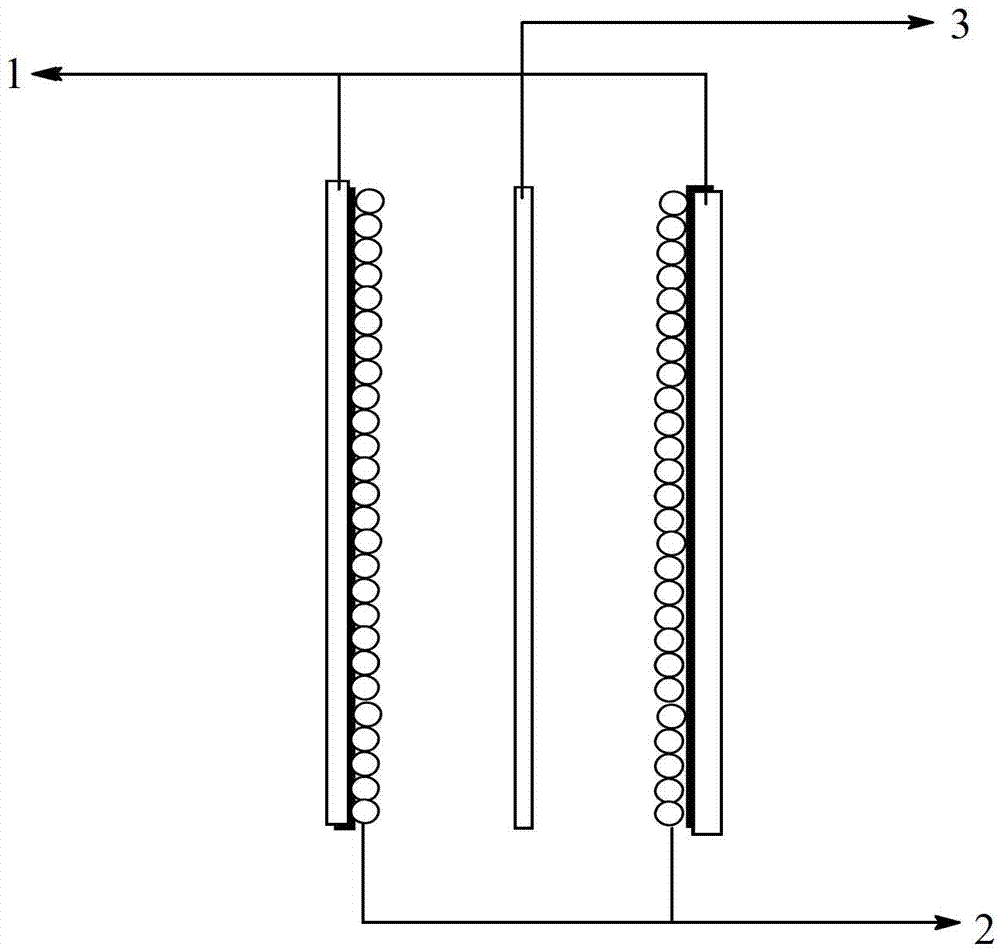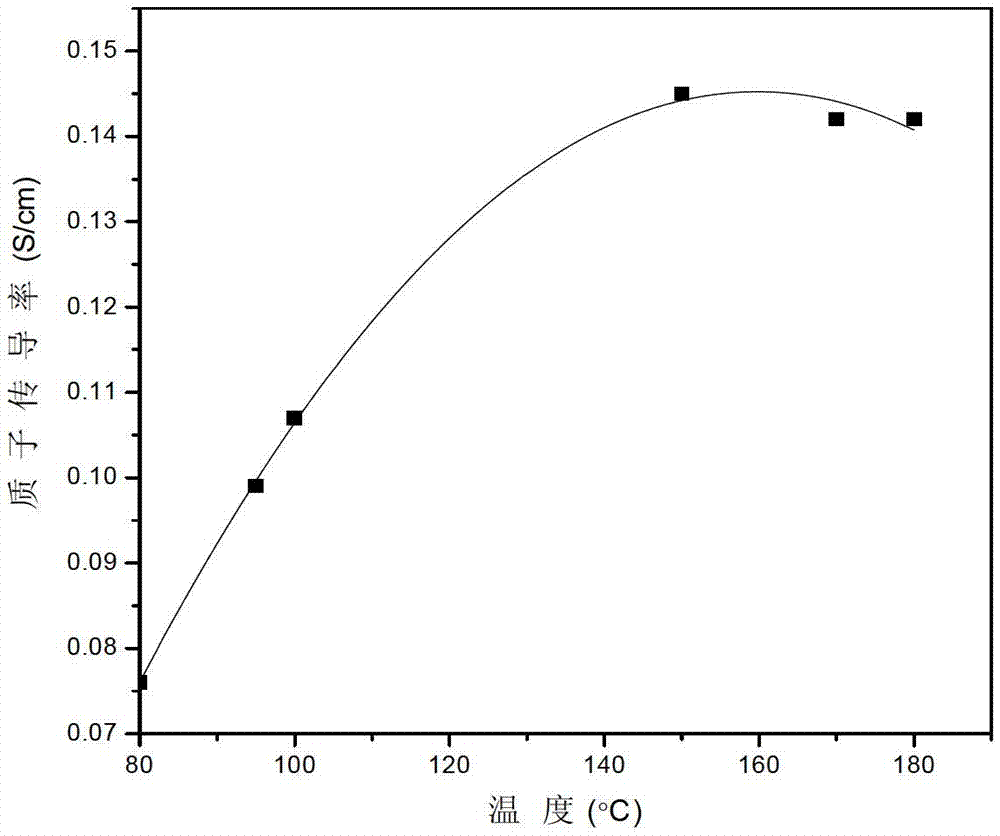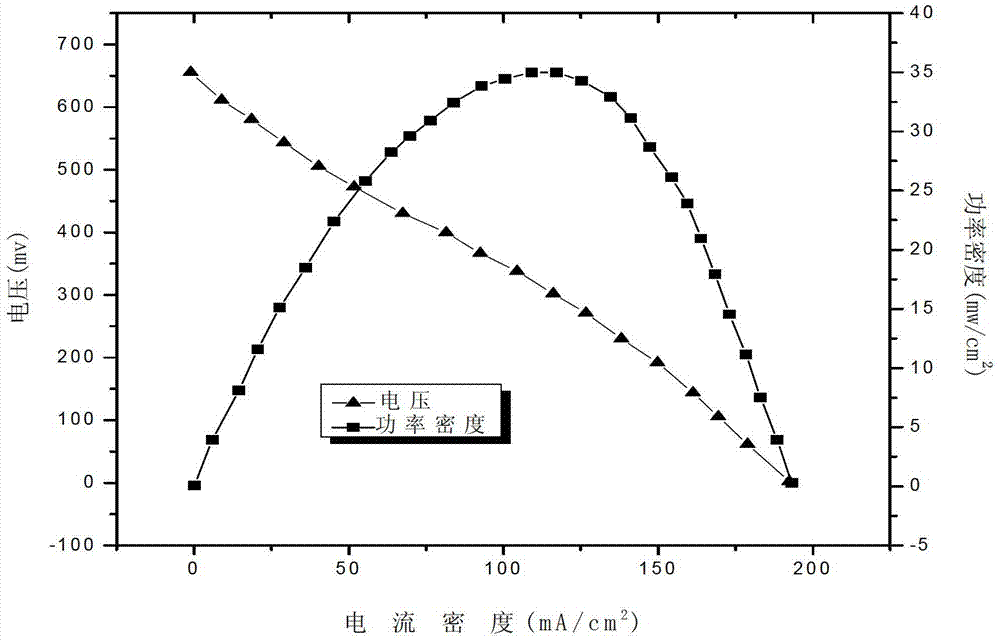Proton exchange membrane and preparation method thereof
A technology for proton exchange membranes and membrane components, which is applied in the manufacture of final products, sustainable manufacturing/processing, solid electrolyte fuel cells, etc., and can solve the problems of inability to obtain continuous and uniform membranes, poor mechanical properties, and no practical value.
- Summary
- Abstract
- Description
- Claims
- Application Information
AI Technical Summary
Problems solved by technology
Method used
Image
Examples
Embodiment 1
[0055] (1) Preparation of mixed poly(p-phenylenebenzobisoxazole) and polyphosphoric acid (PBO / PPA) slurry
[0056] Add 114.90g of 4,6-diaminoresorcinol hydrochloride (DAR), 917.8g of P 2 o 5 Polyphosphoric acid (PPA) with a concentration of 80wt%, 89.55g of terephthalic acid (PTA) with a particle size of 5 microns and 316.50g of P 2 o 5 , Seal the reaction kettle, start the agitator, the stirring direction is the same as the helical direction of the bolt belt, and the rotation speed is 80rpm.
[0057] Raise the temperature of the reaction materials in the reaction kettle to 40°C and keep for 1 hour to make the materials mix initially, then slowly raise the temperature to 65°C and keep for 1 hour. Feed dry high-purity nitrogen gas into the reactor, so that the pressure in the reactor reaches 0.5 MPa, and at the same time raise the temperature to 110°C, keep it for 15 hours, open the pressure relief valve, and remove the pressure from the reactor.
[0058] Then heat up the r...
Embodiment 2
[0068] 1) Preparation of mixed poly(p-phenylenebenzobisoxazole) and polyphosphoric acid (PBO / PPA) slurry
[0069] Add 114.9g of 4,6-diaminoresorcinol hydrochloride (DAR), 920.3g of P 2 o 5 Polyphosphoric acid (PPA) at a concentration of 80 wt%, 152.6g of 2,5-dihydroxyterephthalic acid with a particle size of 5 microns and 326.40g of P 2 o 5 , Seal the reaction kettle, start the agitator, the stirring direction is the same as the helical direction of the bolt belt, and the rotation speed is 80rpm.
[0070]Raise the temperature of the reaction materials in the reactor to 50°C and keep for 1 hour to make the materials mix initially, then slowly raise the temperature to 70°C and keep for 1 hour. Feed dry high-purity nitrogen into the reactor to make the pressure in the reactor reach 1.5MPa, and at the same time raise the temperature to 120°C, keep it for 6 hours, open the pressure relief valve, and remove the pressure from the reactor.
[0071] Then heat up the reaction materi...
Embodiment 3
[0082] (1) Preparation of mixed poly(p-phenylenebenzobisoxazole) and polyphosphoric acid (PBO / PPA) slurry
[0083] Add 114.90g of 4,6-diaminoresorcinol hydrochloride (DAR), 919.3g of P 2 o 5 Polyphosphoric acid (PPA) with a concentration of 80wt%, 109.43g terephthaloyl chloride with a particle size of 5 microns and 321.50gP 2 o 5 , Seal the reaction kettle, start the agitator, the stirring direction is the same as the helical direction of the bolt belt, and the rotation speed is 90rpm.
[0084] Raise the temperature of the reaction materials in the reaction kettle to 45°C and keep for 1 hour to make the materials mix initially, then slowly raise the temperature to 60°C and keep for 1 hour. Feed dry high-purity nitrogen into the reactor to make the pressure in the reactor reach 1.2MPa, and at the same time raise the temperature to 120°C, keep it for 15 hours, open the pressure relief valve, and remove the pressure from the reactor.
[0085] Then the reaction mass was heated...
PUM
| Property | Measurement | Unit |
|---|---|---|
| ionic conductivity | aaaaa | aaaaa |
| thickness | aaaaa | aaaaa |
| particle diameter | aaaaa | aaaaa |
Abstract
Description
Claims
Application Information
 Login to View More
Login to View More - Generate Ideas
- Intellectual Property
- Life Sciences
- Materials
- Tech Scout
- Unparalleled Data Quality
- Higher Quality Content
- 60% Fewer Hallucinations
Browse by: Latest US Patents, China's latest patents, Technical Efficacy Thesaurus, Application Domain, Technology Topic, Popular Technical Reports.
© 2025 PatSnap. All rights reserved.Legal|Privacy policy|Modern Slavery Act Transparency Statement|Sitemap|About US| Contact US: help@patsnap.com



